Laser-Assisted Removal of Graffiti from Granite: Advantages of the Simultaneous Use of Two Wavelengths
Abstract
:1. Introduction
2. Materials and Methods
2.1. Granite and Glass Slabs
2.2. Spray Graffiti Paints and Painting Procedure
2.3. Laser System and Parameters
2.4. Experimental Methodology
2.5. Analytical Techniques
3. Results
3.1. Damage Thresholds of the Vilachán Granite
- The characteristic yellowish-brown color of the rock lost intensity, as detected by stereomicroscopy (Figure 1(c1,d1)).
- Biotite grains melted, as seen by SEM, especially for high fluence values (Figure 1(c3,d3)).
- The roughness of the surface was modified especially when high fluence values were employed; SEM micrographs at low magnification (Figure 1(c2,d2)) show wide and deep valleys on the rock surface upon extreme irradiation conditions. The surface roughness (Ra) was increased due to the extraction of mineral grains (also verified by stereomicroscopy and SEM-Figure 1(c1,d1) from 14.89 ± 0.79 µm (reference surface—Figure 1(a1) up to 25.20 ± 0.63 µm (at 1.5 J·cm−2—Figure 1(d1)).
3.2. Extraction Thresholds of the Graffiti Paints
3.3. Characterization of Graffiti Layers on Granite
- Blue graffiti (Figure 3a and its EDS spectrum). These films, rich in C, Si, Ti and Mg, were characterized by a mixture of scales of different sizes and shapes embedded in a C-rich matrix.
- Black graffiti (Figure 3b and its EDS spectrum) appeared as a homogeneous film composed exclusively of carbon.
- Silver graffiti (Figure 3c and its EDS spectrum) was composed of laminar shaped particles (<10 µm in size) rich in Al.
3.4. Determination of the Irradiation Conditions
3.5. Evaluation of the Graffiti Laser Cleaning-Tests
- Blue graffiti (Figure 4b–d). In the 1064 nm regime, the best laser cleaning result was obtained with 150 pulses at 1 J·cm−2, although blue remains were still visible. In the 355 nm regime, 90 pulses at 0.4 J·cm−2 resulted into satisfactory cleaning. The best condition for the simultaneous application of both wavelengths was achieved with the FIR/FUV ratio 1/3 and fluence values of 0.1 and 0.3 J·cm−2 respectively (27 pulses). Irradiation involving 355 nm (either alone or in combination with the 1064 nm) always removed the graffiti paint; however, the characteristic yellowish-brown color of the rock appeared faded/altered when compared to the reference surface.
- Black graffiti (Figure 4e–h). Both laser beams removed the black graffiti layer efficiently. The most favorable results were obtained at 1064 nm with 28 pulses at 1 J·cm−2 and, at 355 nm, with 60 pulses at 0.4 J·cm−2. Interestingly, the simultaneous application of both wavelengths gave similar results for the ratios 1/3 and 3/1: Specifically, the area irradiated with FIR/FUV = 0.3/0.1 J·cm−2 (18 pulses) appeared visually similar to the one cleaned with FIR/FUV = 0.1/0.3 J·cm−2 (18 pulses). Regarding the damage on the granite, the yellowish color of the rock was intensified after the irradiation at 1064 nm; this same effect, although not as intense, occurred with the combined beams. Conversely, the irradiation with 355 nm caused a slight fading of the original color of the stone.
- Silver graffiti (Figure 4i–k). None of the experiments were able to eliminate silver paint. Moreover, in contrast to the irradiation of the other graffiti paints, an intense ablation plume was observed during the irradiation. The treated surfaces appeared darker than the untreated rock; a continuous film (in which remnants of silver color were clearly identified) was detected by stereomicroscopy on the surfaces cleaned at 355 nm. Despite the unsatisfactory cleaning outcome, several parameters were selected to be further analytically examined aiming to approach the reason for such a result; 9 pulses of 0.5 J·cm−2 for the 1064 nm and 355 nm individually and 12 pulses of FIR/FUV = 0.3/0.1 J·cm−2 for their combination with a FIR/FUV ratio 3/1.
- Blue graffiti. Negative Δa* and Δb* values were obtained, indicating a loss of the original yellowish-brown hue of the rock. Specifically, negative Δb* values (particularly for the 1064 nm cleaning tests) are indicative of unsuccessful cleaning level and blue graffiti remnants on the surface. The most satisfactory result, based on CIELAB characterization, corresponds to the cleaning with 355 nm (ΔE*ab = 6.15 CIELAB units).
- Black graffiti. Noticeable positive Δb* values were obtained upon IR irradiation as well as its FIR/FUV = 3/1 combination. This change indicates an increase to the intensity of the original yellowish color of the rock. Conversely, negative Δb* values were obtained upon single UV irradiation and its FIR/FUV = 1/3 combination, indicating fading of the original granite color. These results agree with stereomicroscopic observations. The surfaces cleaned with the IR beam or the combined beams with the higher IR contribution, exhibited increased ΔE*ab (>11 CIELAB units), while the surfaces treated with the UV beam or the combined beams with the higher UV contribution, showed lower ΔE*ab (~9 CIELAB units) and, in consequence, they are closer to the reference. In this sense, the treatment with UV irradiation would be the most effective in removing the black graffiti.
- Silver graffiti. The darkening observed by stereomicroscope is confirmed from the values of ΔL*, and consequently the ΔE*ab, which are the highest ones among all the samples (up to 25 CIELAB units). This darkening effect was most intense upon UV irradiation (as an individual beam or combined with IR). Moreover, 1064 nm resulted into the lowest ΔE*ab (14.84 CIELAB units), although the cleaning of silver graffiti was not satisfactory.
- Blue graffiti (Figure 5a): Effects assigned to blue paint (functional groups C–H, C=O and C–O–C) were identified only on the surfaces cleaned with IR radiation. On samples treated with UV beam (either single UV or simultaneously with IR), only the bands typical of silicates were detected.
- Black graffiti (Figure 5b): FTIR spectra of functional groups assigned to this paint were detected only on the surfaces treated with the single IR beam and its FIR/FUV = 3/1 combination. These organic remains could contribute to the increase of the yellowish tone of the rock detected by stereomicroscopy and confirmed by color measurements.
- Silver graffiti (Figure 5c): The spectra obtained does not allow us to consistently evaluate the effectiveness of the cleaning of this paint, because the high reflectance of the Al-rich particles masked the bands of the organic groups of the binder. Despite this, after laser cleaning the bands at 2925 cm−1 and 2854 cm−1 (corresponding to C–H asymmetric stretching vibrations of alkanes) are slightly increased. This indicates that a significant amount of Al particles has been extracted, thus making it possible for the FTIR to detect the organic fraction of the paint which remains on the surface (and is also observed under stereomicroscopy and SEM).
- Blue graffiti (Figure 6a–c). No remains of this paint were found on the surfaces treated with the simultaneous use of both wavelengths (FIR/FUV ratio 1/3) (Figure 6c). Therefore, this condition is identified as the most efficient one, in accordance with stereomicroscopy and FTIR. Conversely, on areas irradiated with the IR beam, paint remains were detected (Figure 6a) and, at lesser extent, remains were also found on the surface irradiated with the UV beam (Figure 6b).
- Black graffiti (Figure 7). C-rich deposits (solid black deposits in Figure 7a) and a C-rich film (greyish coloration in Figure 7a) were detected on the surfaces irradiated at 1064 nm. On areas treated with the combined wavelengths at FIR/FUV ratio 3/1 (Figure 7c,d), even though a C-rich film was also detected (Figure 7d), less amount of C-rich deposits was identified (Figure 7c) comparatively to the surface treated with 1064 nm irradiation (Figure 7a). On areas irradiated with the two wavelengths simultaneously at FIR/FUV ratio 1/3 (Figure 7e,f) only discrete C-rich deposits were identified (solid black remains on Figure 7e). Finally, on the sample treated with single UV beam, no C-rich remains were detected (Figure 7b).
- Silver graffiti (Figure 6d–f). After IR irradiation (Figure 6d), a C-rich film was clearly detected on the surface. Irradiation with UV (either as a single beam—Figure 6e—or in combination with IR—Figure 6f), this film was accompanied by a large number of Al particles distributed throughout the surface. This finding was also reported in [15] after the treatment of the same graffiti with a Nd:YVO4 at 355 nm.
4. Discussion
4.1. Determination of Damage Thresholds of Granite and Extraction Thresholds of Graffiti Paints
4.2. Blue and Black Graffiti Cleaning
4.3. Silver Graffiti Cleaning
5. Conclusions
Acknowledgments
Author Contributions
Conflicts of Interest
References
- GRAFFITAGE: Development of a New Anti-Graffiti System, Based on Traditional Concepts, Preventing Damage of Architectural Heritage Materials. SSP (Policy Oriented Research) of the Sixth European Programme of the European Commission. FP6-2003-SSP3-513718. 2008. Available online: https://cordis.europa.eu/result/rcn/52034_es.html (accessed on 27 February 2018).
- Sanmartín, P.; Cappitelli, F.; Mitchell, R. Current methods of graffiti removal: A review. Constr. Build. Mater. 2014, 71, 363–374. [Google Scholar] [CrossRef]
- GRAFFOLUTION: Awareness and Prevention Solutions against Graffiti Vandalism in Public Areas and Transport. SSP (Policy Oriented Research) of the Seventh European Programme of the European Commission. FP7-SEC-2013-1. 2016. Available online: https://trimis.ec.europa.eu/project/awareness-and-prevention-solutions-against-graffiti-vandalism-public-areas-and-transport (accessed on 27 February 2018).
- Gomes, V.; Dionísio, A.; Pozo-Antonio, J.S. Conservation strategies against graffiti vandalism on cultural heritage stones: Protective coatings and cleaning methods. Prog. Org. Coat. 2017, 113C, 90–109. [Google Scholar] [CrossRef]
- Carmona-Quiroga, P.M.; Panas, I.; Svensson, J.E.; Johansson, L.G.; Blanco-Varela, M.T.; Martínez-Ramírez, S. Protective performances of two anti-graffiti treatments towards sulfite and sulfate formation in SO2 polluted model environment. Appl. Surf. Sci. 2010, 257, 852–856. [Google Scholar] [CrossRef]
- Carmona-Quiroga, P.M.; Jacobs, R.M.; Martínez-Ramírez, S.; Viles, H.A. Durability of anti-graffiti coatings on stone: Natural vs. accelerated weathering. PLoS ONE 2017, 12, e0172347. [Google Scholar] [CrossRef] [PubMed]
- Cooper, M. Laser Cleaning in Conservation: An Introduction; Butterworth-Heinemann: Oxford, UK, 1998. [Google Scholar]
- Fotakis, C.; Anglos, D.; Zafiropulos, V.; Georgiou, S.; Tornari, V. Lasers in the Preservation of Cultural Heritage: Principles and Applications; Brown, R.G.W., Pike, E.R., Eds.; CRC Press: Boca Raton, FL, USA, 2006. [Google Scholar]
- Siano, S.; Giamello, M.; Bartoli, L.; Mencaglia, A.; Parfenov, V.; Salimbeni, R. Laser cleaning of stone by different laser pulse duration and wavelength. Laser Phys. 2008, 18, 27. [Google Scholar] [CrossRef]
- Vergès-Belmin, V.; Rolland, O.; Jourd’heuil, I.; Guiavarc’h, M.; Zanini, A. Nd:YAG long Q-switched versus short free running laser cleaning trials at Chartres cathedral, France. Stud. Conserv. 2015, 60, S12–S18. [Google Scholar] [CrossRef]
- Iglesias-Campos, M.A.; Prada-Pérez, J.L. Actual laser removal of black soiling crust from siliceous sandstone by high pulse repetition rate equipment: Effects on surface morphology. Mater. Constr. 2016, 66, e078. [Google Scholar] [CrossRef]
- Pouli, P.; Papakonstantinou, E.; Frantzikinaki, K.; Panou, A.; Frantzi, G.; Vasiliadis, C.; Fotakis, C. The two-wavelength laser cleaning methodology; theoretical background and examples from its application on CH objects and monuments with emphasis to the Athens Acropolis sculptures. Herit. Sci. 2016, 4, 9. [Google Scholar] [CrossRef]
- Senesi, G.S.; Carrara, I.; Nicolodelli, G.; Milori, D.M.B.P.; De Pascale, O. Laser cleaning and laser-induced breakdown spectroscopy applied in removing and characterizing black crusts from limestones of Castello Svevo, Bari, Italy: A case study. Microchem. J. 2016, 124, 296–305. [Google Scholar] [CrossRef]
- Sanz, M.; Oujja, M.; Ascaso, C.; Pérez-Ortega, S.; Souza-Egipsy, V.; Fort, R.; de los Ríos, A.; Wierzchos, J.; Cañamares, M.V.; Castillejo, M. Influence of wavelength on the laser removal of lichens colonizing heritage stone. Appl. Surf. Sci. 2017, 399, 758–768. [Google Scholar] [CrossRef]
- Rivas, T.; Pozo, S.; Fiorucci, M.P.; López, A.J.; Ramil, A. Nd:YVO4 laser removal of graffiti from granite. Influence of paint and rock properties on cleaning efficacy. Appl. Surf. Sci. 2012, 263, 563–572. [Google Scholar]
- Samolik, S.; Walczak, M.; Plotek, M.; Sarzynski, A.; Pluska, I.; Marczak, J. Investigation into the removal of graffiti on mineral supports: Comparison of nanosecond Nd:YAG laser cleaning with traditional mechanical and chemical methods. Stud. Conserv. 2015, 60, S58–S64. [Google Scholar] [CrossRef]
- Pozo-Antonio, J.S.; Rivas, T.; Fiorucci, M.P.; López, A.J.; Ramil, A. Effectiveness and harmfulness evaluation of graffiti cleaning by mechanical, chemical and laser procedures on granite. Microchem. J. 2016, 125, 1–9. [Google Scholar] [CrossRef]
- Ramil, A.; Pozo-Antonio, J.S.; Fiorucci, M.P.; López, A.J.; Rivas, T. Detection of the optimal laser fluence ranges to clean graffiti on silicates. Constr. Build. Mater. 2017, 148, 122–130. [Google Scholar]
- Sanjeevan, P.; Klemm, A.J.; Klemm, P. Removal of graffiti from the mortar by using Q-switched Nd:YAG laser. Appl. Surf. Sci. 2007, 253, 8543–8553. [Google Scholar] [CrossRef]
- Gomez, C.; Costela, A.; García-Moreno, I.; Sastre, R. Comparative study between IR and UV laser radiation applied to the removal of graffitis on urban buildings. Appl. Surf. Sci. 2006, 252, 2782–2793. [Google Scholar] [CrossRef]
- Costela, A.; Garcı́a-Moreno, I.; Gómez, C.; Caballero, O.; Sastre, R. Cleaning graffitis on urban buildings by use of second and third harmonic wavelength of a Nd:YAG laser: A comparative study. Appl. Surf. Sci. 2003, 207, 86–99. [Google Scholar]
- Delgado Rodrigues, J.; Costa, D.; Mascalchi, M.; Osticioli, I.; Siano, S. Laser ablation of iron-rich black films from exposed granite surfaces. Appl. Phys. A 2017, 117, 365–370. [Google Scholar] [CrossRef]
- Fiorucci, M.P.; Lamas, J.; López, A.J.; Rivas, T.; Ramil, A. Laser cleaning of graffiti in Rosa Porriño granite. Proc. SPIE Int. Soc. Opt. Eng. 2011, 8001, 80014A. [Google Scholar] [CrossRef]
- Pouli, P.; Oujja, M.; Castillejo, M. Practical issues in laser cleaning of stone and painted artefacts: Optimization procedures and side effects. Appl. Phys. A 2012, 106, 447–464. [Google Scholar] [CrossRef]
- IGME (Instituto Geológico y Minero de España). Mapa geológico de España. Serie Magna, E-1:50.000, 2nd ed.; Ministerio de Industria y Energía: Madrid, Spain, 1985. (In Spanish)
- RILEM. Commission 25 PEM. Protection et Erosion des Monuments. Recommandations provisoires. Essais recommandés pour mesurer l’altération des pièrres et évaluer l’efficacité des méthodes de traitement. Test No. II. 1: Open Porosity. Matériaux de Constructions 1980, 13. (In French) [Google Scholar]
- Kliem, W.; Lehmann, G. A reassignment of the optical absorption bands in biotites. Phys. Chem. Miner. 1979, 4, 65–75. [Google Scholar] [CrossRef]
- ISO 4288 Geometrical Product Specifications (GPS)—Surface Texture: Profile Method, Terms, Definitions and Surface Texture Parameters; International Organization for Standardization: Geneva, Switzerland, 1999.
- CIE S014-4/E: 2007 Colorimetry Part 4: CIE 1976 L*a*b* Colour Space, Commission Internationale de l’eclairage; CIE Central Bureau: Vienna, Austria, 2007.
- Prieto, B.; Sanmartín, P.; Silva, B.; Martínez-Verdú, F. Measuring the color of granite rocks: A proposed procedure. Color Res. Appl. 2010, 35, 368–375. [Google Scholar] [CrossRef]
- Liu, J.M. Simple technique for measurements of pulsed Gaussian-beam spot sizes. Opt. Lett. 1982, 7, 196–198. [Google Scholar] [CrossRef] [PubMed]
- Socrates, G. Infrared and Raman Characteristic Group Frequencies: Tables and Charts, 3rd ed.; John Wiley and Sons: Hoboken, NJ, USA, 2001. [Google Scholar]
- Escuder, J.; Carbonell, R.; Martí, D.; Pérez-Estaún, A. Interacción fluido-roca a lo largo de las superficies de fractura: Efectos mineralógicos y texturales de las alteraciones observadas en el Plutón Granítico de Albalá, SO del Macizo Hercínico Ibérico. Boletín Geológico y Minero 2001, 112, 59–78. (In Spanish) [Google Scholar]
- Yonehara, M.; Matsui, T.; Kihara, K.; Isono, H.; Kijima, A.; Sugibayashi, T. Experimental relationships between surface roughness, glossiness and color of chromatic colored metals. Mater. Trans. 2005, 4, 1027–1032. [Google Scholar] [CrossRef]
- Urones-Garrote, E.; López, A.; Ramil, A.; Otero-Díaz, L.C. Microstructural study of the origin of color in Rosa Porriño granite and laser cleaning effects. Appl. Phys. A 2011, 104, 95–101. [Google Scholar] [CrossRef]
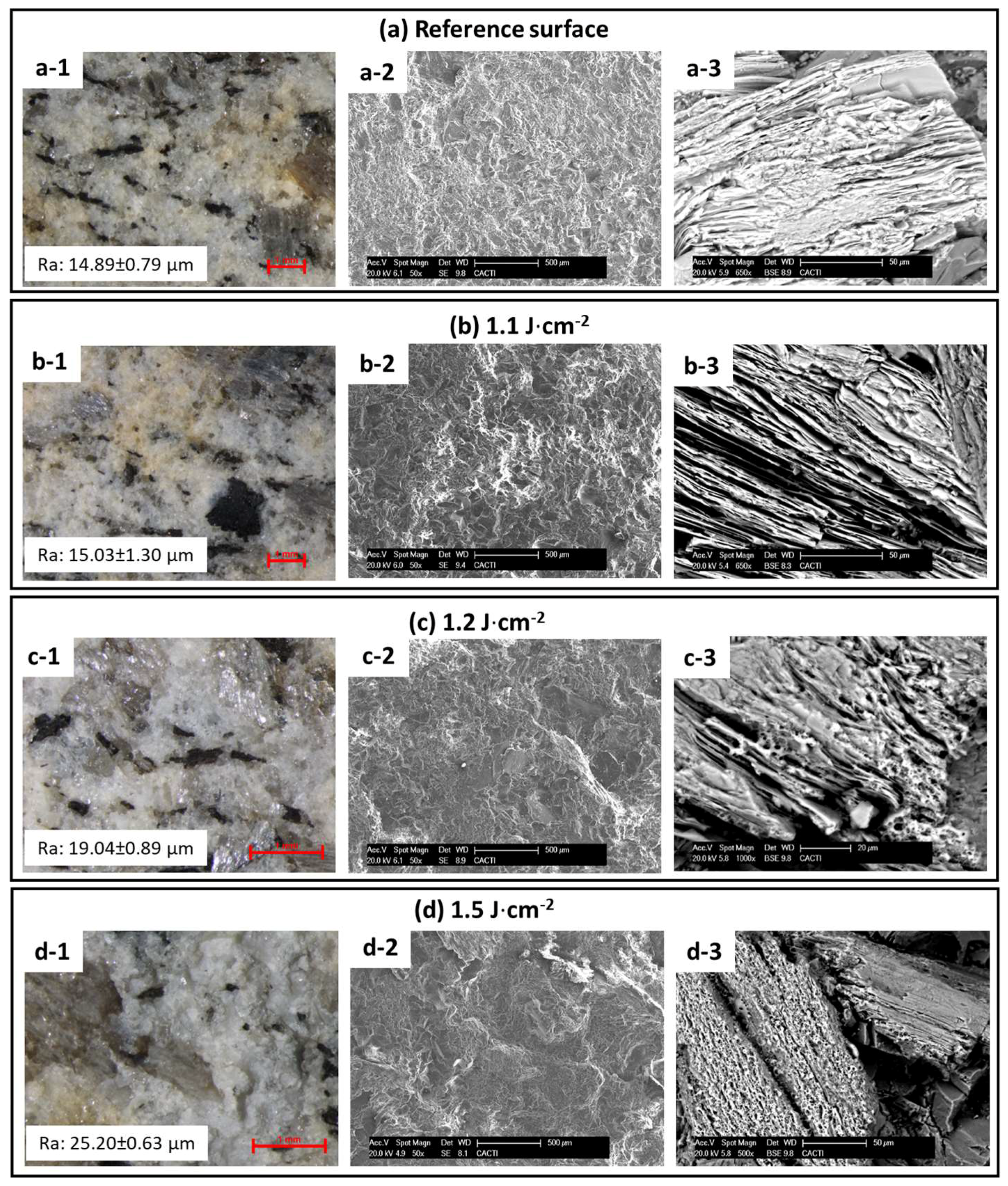
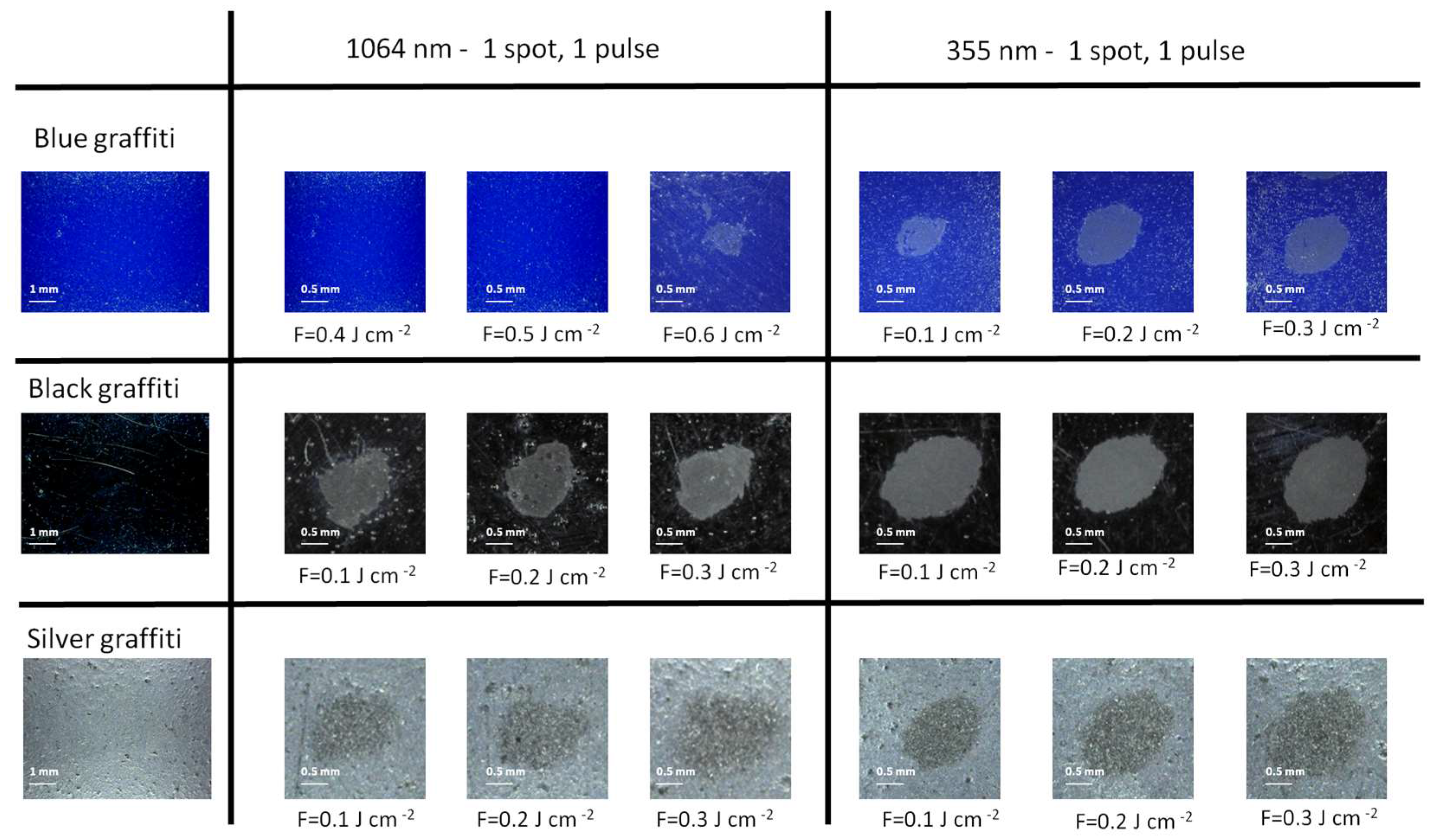
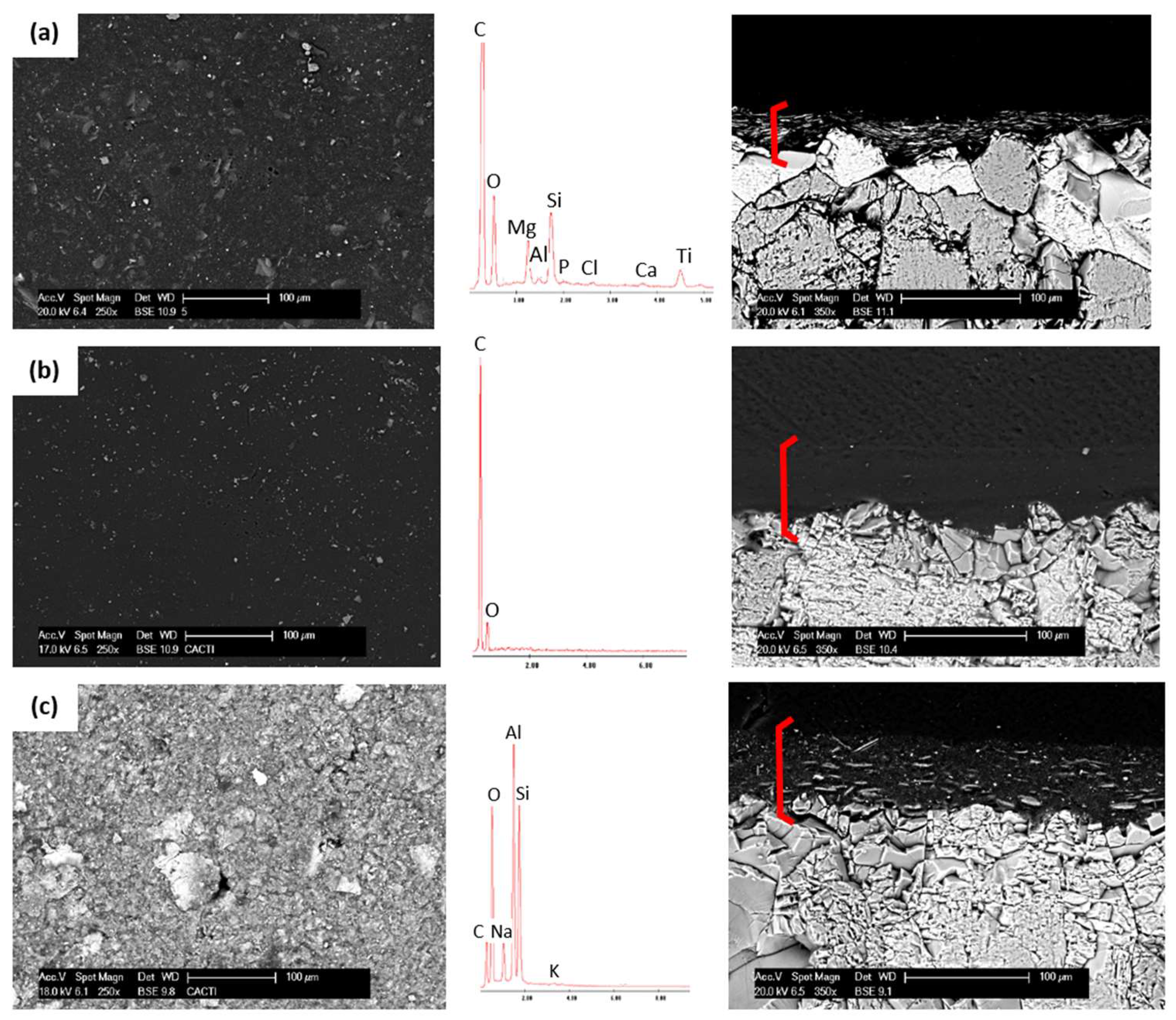
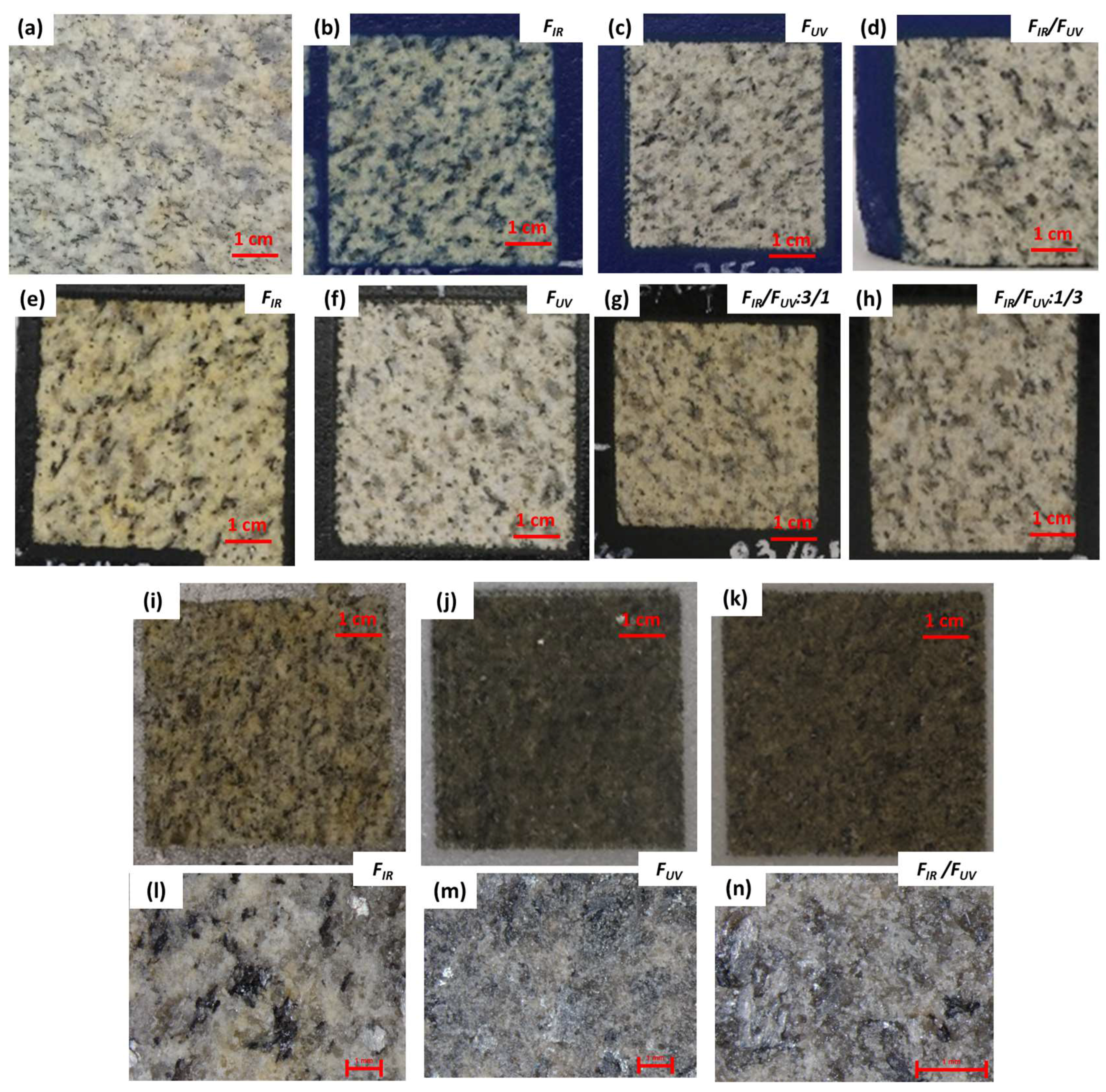
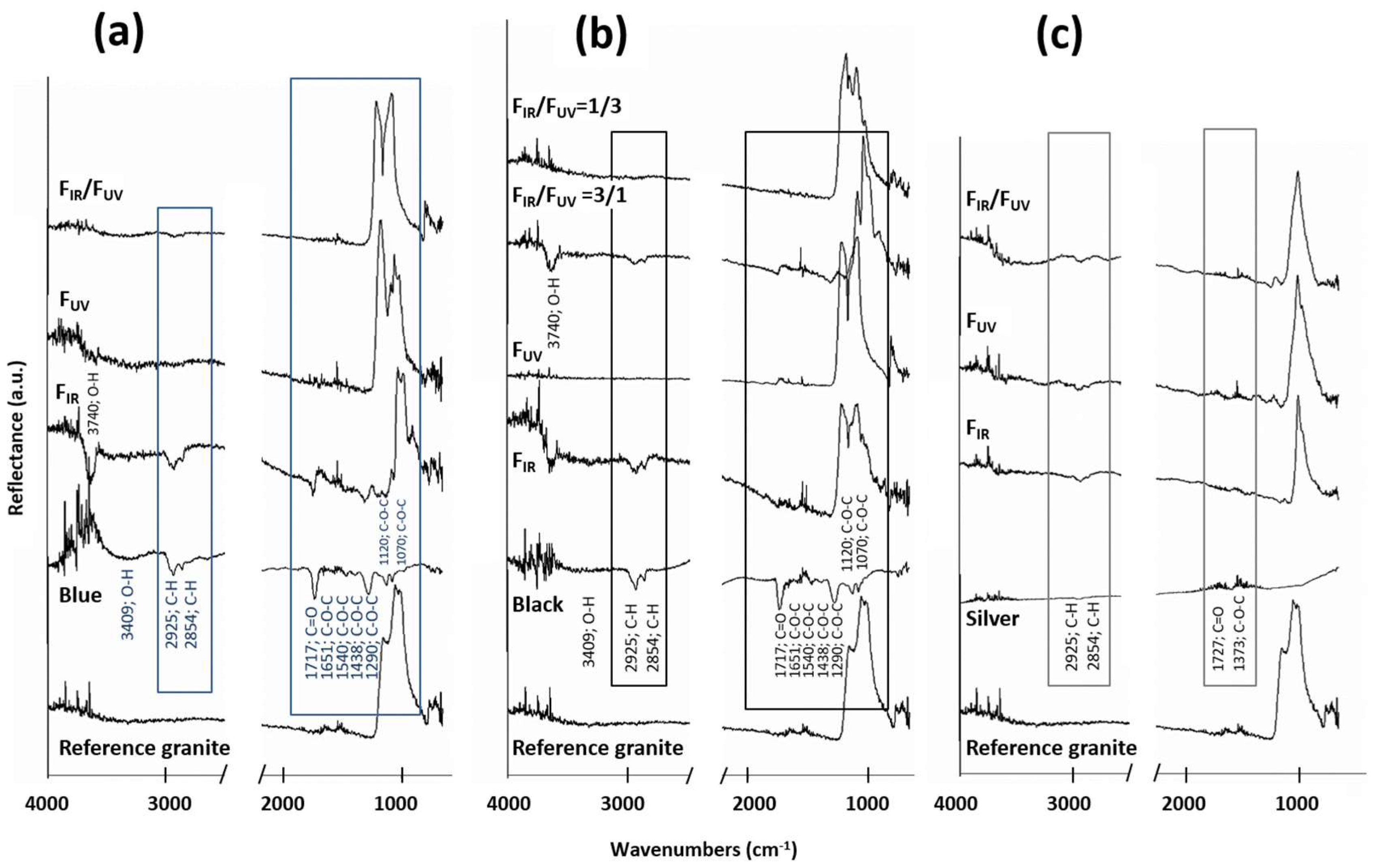
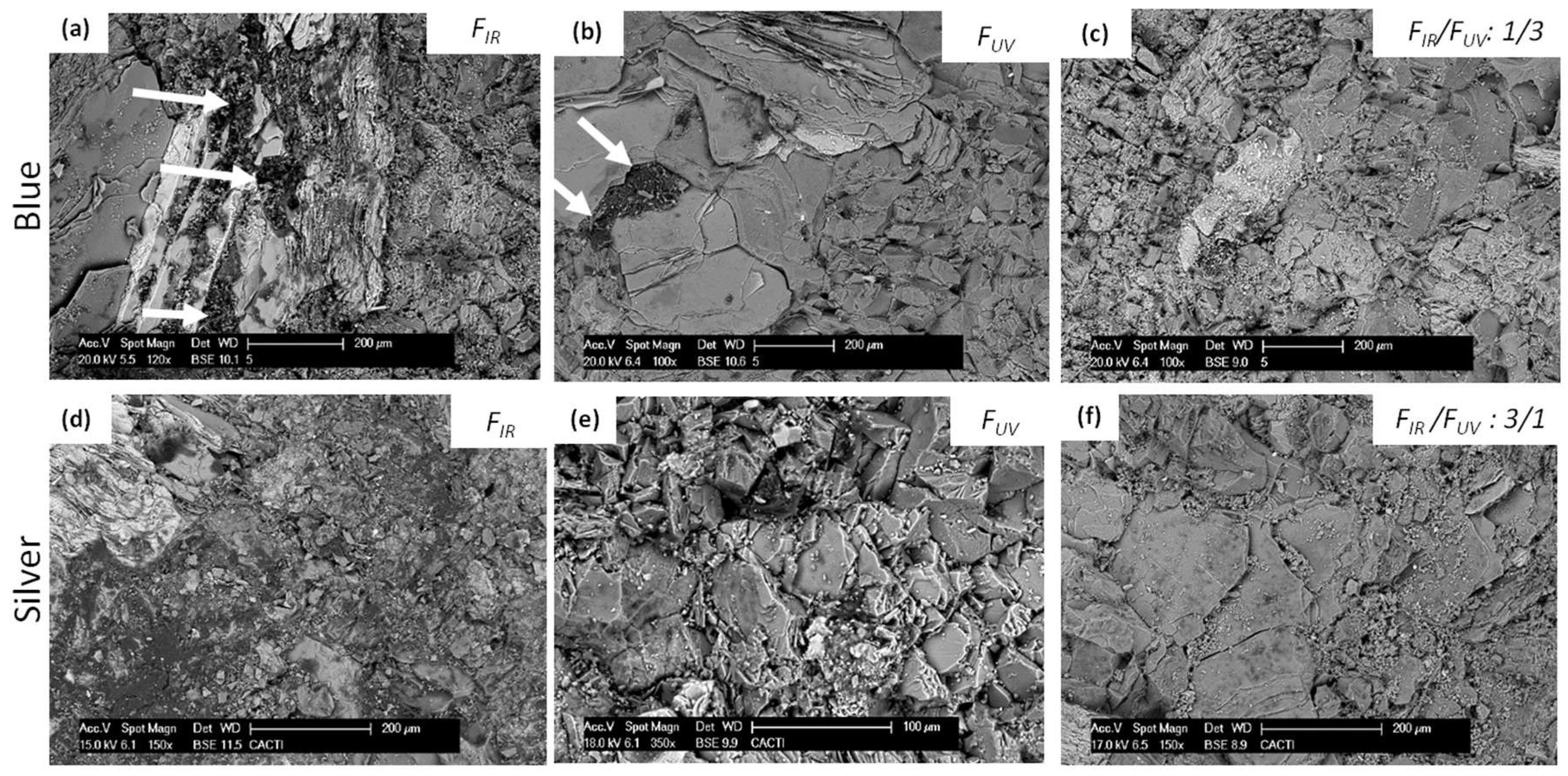
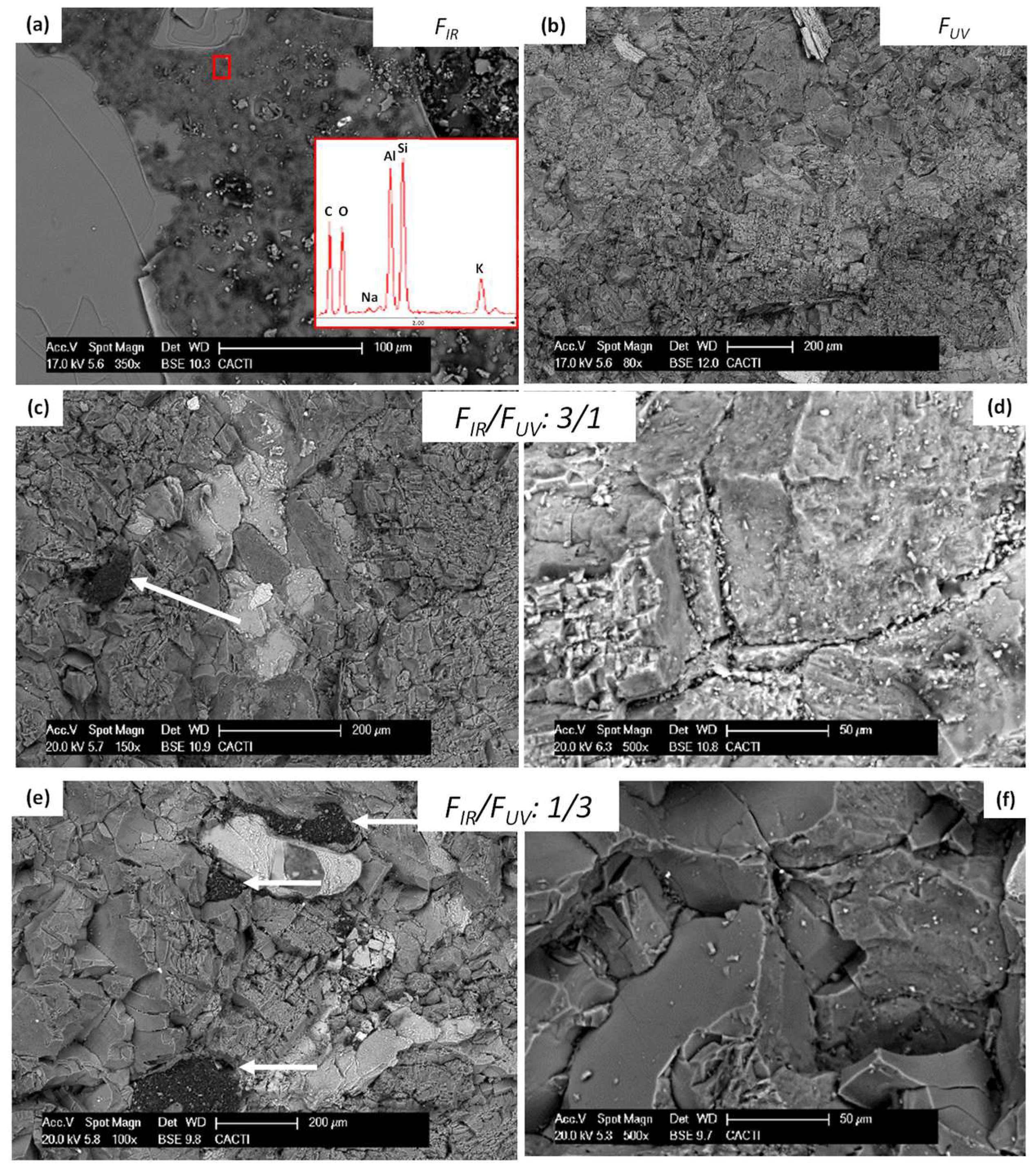
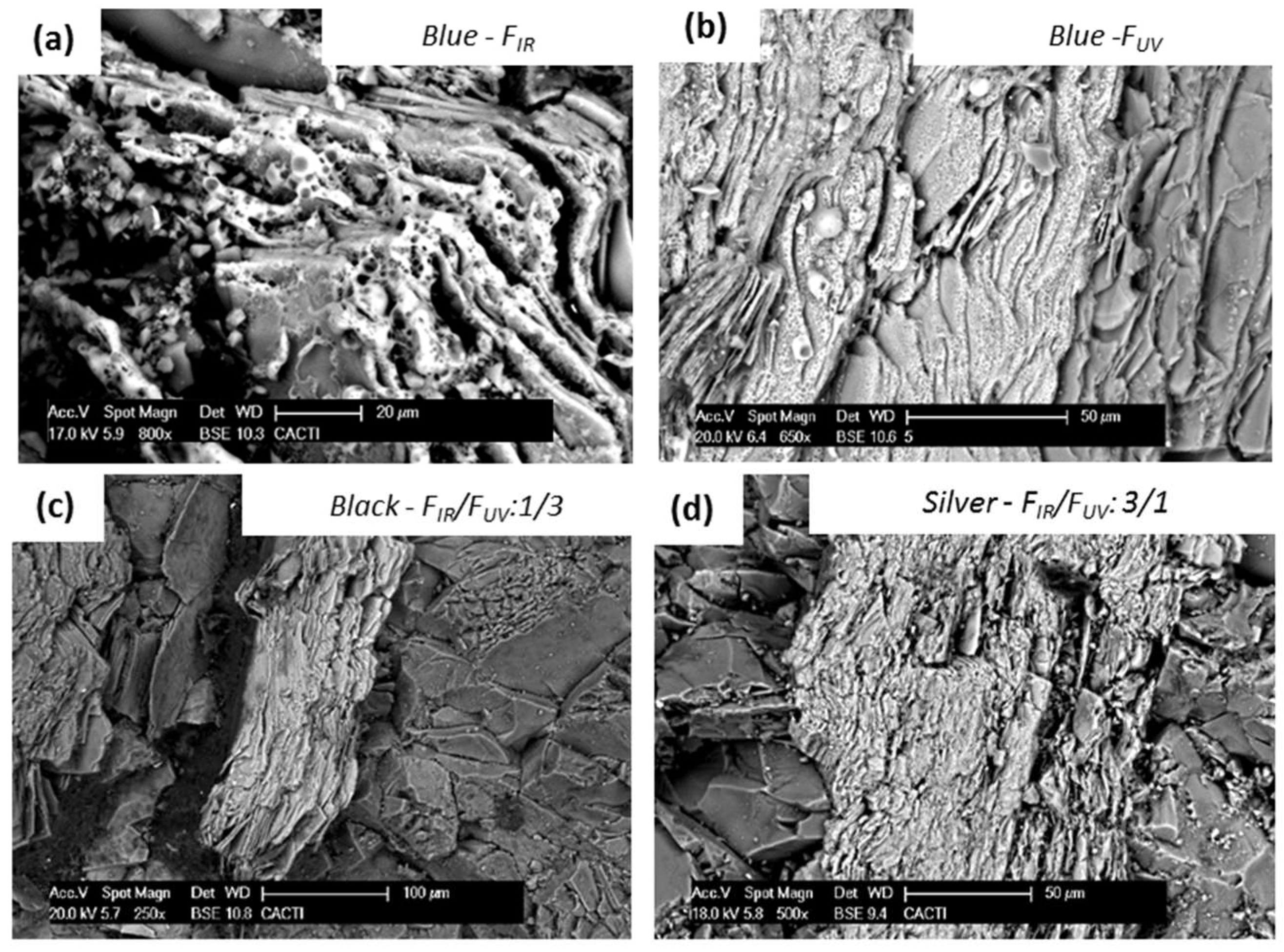
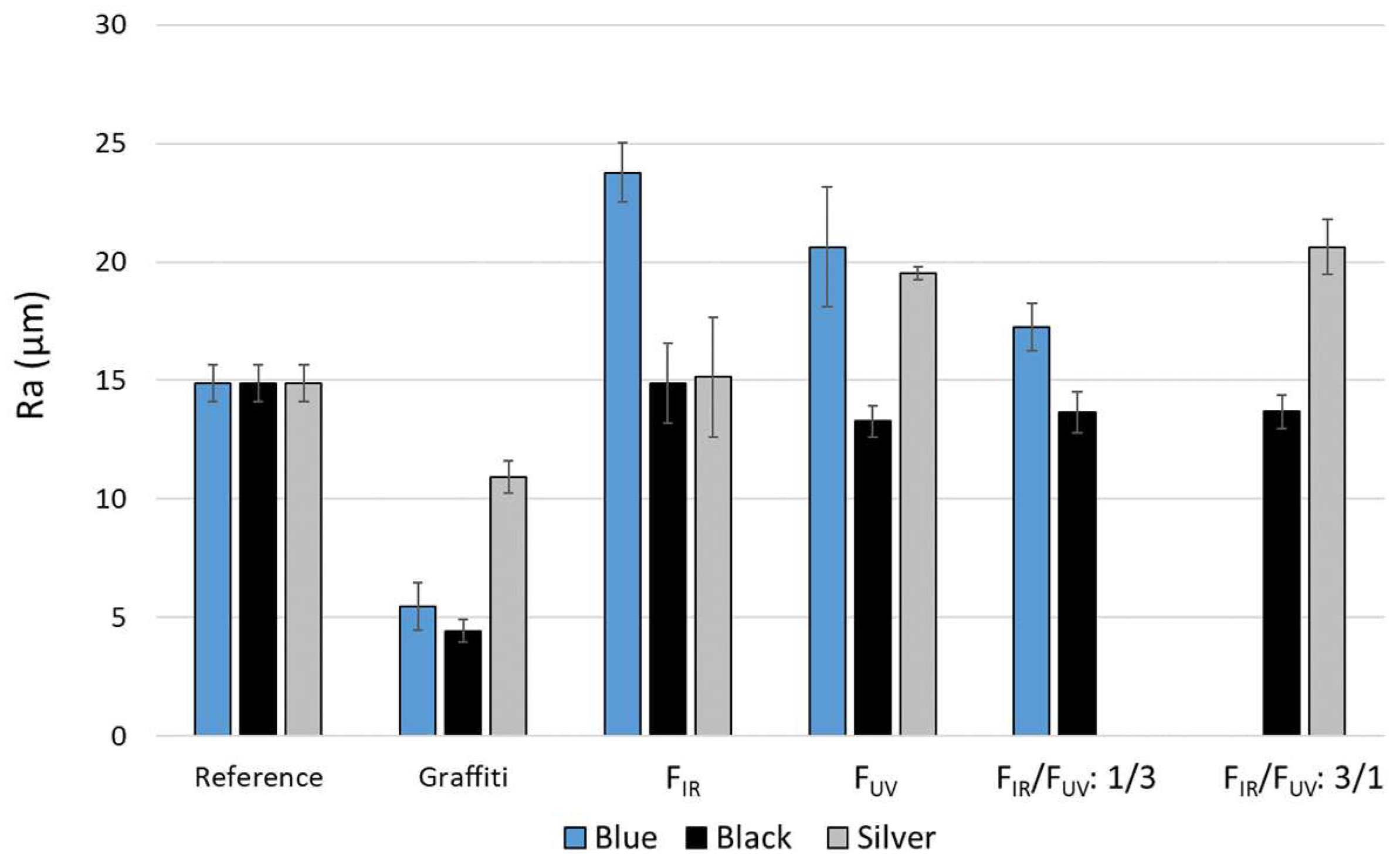

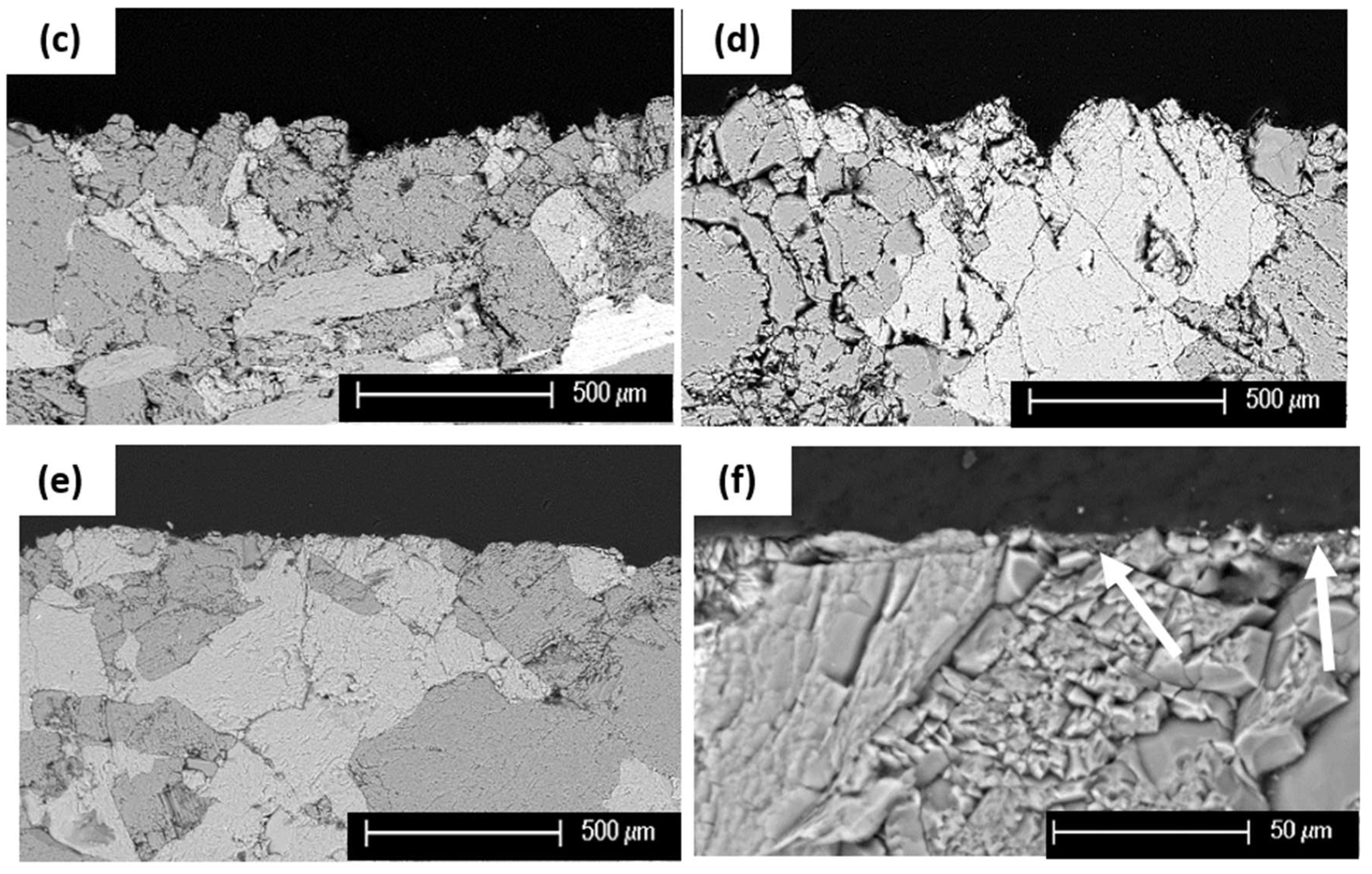
| Sample | Wavelength (nm) | Range of Tested Fluence Values (J·cm−2) | Threshold (J·cm−2, 1 p) | Theoretical Threshold (J·cm−2) |
|---|---|---|---|---|
| Granite | 1064 | 0.6–2.3 | 1.1 | – |
| 355 | 0.2–1.0 | 0.7 | – | |
| Blue Graffiti | 1064 | 0.1–1.0 | 0.5 | 0.333 ± 0.048 |
| 355 | <0.1 | 0.027 ± 0.001 | ||
| Black Graffiti | 1064 | <0.1 | 0.009 ± 0.002 | |
| 355 | <0.1 | 0.012 ± 0.001 | ||
| Silver Graffiti | 1064 | <0.1 | 0.030 ± 0.001 | |
| 355 | <0.1 | 0.011 ± 0.001 |
| Single Wavelength Irradiation | |||
| Wavelength (nm) | Fluence Values Tested (J·cm−2) | Selected Conditions per Graffiti Color: Fluence Values in J·cm−2 (Number of Pulses) | |
| 1064 | 0.4–1.2 | Blue | 1.0 (150) |
| Black | 1.0 (28) | ||
| Silver | 0.5 (9) | ||
| 355 | 0.2–1.0 | Blue | 0.4 (90) |
| Black | 0.4 (60) | ||
| Silver | 0.5 (9) | ||
| Irradiation Using the Two Wavelengths Simultaneously | |||
| FIR/FUV Ratio | Fluence Values Tested (J·cm−2) | Selected Conditions per Graffiti Color: Fluence Values in J·cm−2 (Number of Pulses) | |
| 1/1 | 0.2/0.2 | – | – |
| 0.3/0.3 | – | – | |
| 0.4/0.4 | – | – | |
| 1/3 | 0.1/0.3 | Blue | 0.1/0.3 (27) |
| Black | 0.1/0.3 (18) | ||
| 0.2/0.6 | – | – | |
| 0.3/0.9 | – | – | |
| 3/1 | 0.3/0.1 | Black | 0.3/0.1 (18) |
| Silver | 0.3/0.1 (12) | ||
| 0.6/0.2 | – | – | |
| 0.9/0.3 | – | – | |
| Graffiti | Wavelength | ∆L* | ∆a* | ∆b* | ∆C*ab | ∆E*ab |
|---|---|---|---|---|---|---|
| Blue | IR | −10.67 | −4.40 | −5.98 | −3.60 | 13.00 |
| UV | −5.60 | −0.59 | −2.48 | 1.10 | 6.15 | |
| FIR/FUV: 1/3 | −6.63 | −0.59 | −2.56 | −0.07 | 7.13 | |
| Black | IR | −11.66 | 1.26 | 7.72 | 8.26 | 14.04 |
| UV | −8.49 | 0.14 | −0.65 | −8.45 | 8.52 | |
| FIR/FUV: 3/1 | −11.78 | 0.68 | 1.88 | 2.58 | 11.95 | |
| FIR/FUV: 1/3 | −9.29 | 0.00 | −1.95 | −3.82 | 9.50 | |
| Silver | IR | −14.59 | 0.56 | 2.67 | 5.29 | 14.84 |
| UV | −25.92 | 0.28 | −2.60 | −5.27 | 26.05 | |
| FIR/FUV: 3/1 | −23.39 | 0.60 | −0.52 | 2.10 | 23.41 |
© 2018 by the authors. Licensee MDPI, Basel, Switzerland. This article is an open access article distributed under the terms and conditions of the Creative Commons Attribution (CC BY) license (http://creativecommons.org/licenses/by/4.0/).
Share and Cite
Pozo-Antonio, J.S.; Papanikolaou, A.; Melessanaki, K.; Rivas, T.; Pouli, P. Laser-Assisted Removal of Graffiti from Granite: Advantages of the Simultaneous Use of Two Wavelengths. Coatings 2018, 8, 124. https://doi.org/10.3390/coatings8040124
Pozo-Antonio JS, Papanikolaou A, Melessanaki K, Rivas T, Pouli P. Laser-Assisted Removal of Graffiti from Granite: Advantages of the Simultaneous Use of Two Wavelengths. Coatings. 2018; 8(4):124. https://doi.org/10.3390/coatings8040124
Chicago/Turabian StylePozo-Antonio, José Santiago, Athanasia Papanikolaou, Kristalia Melessanaki, Teresa Rivas, and Paraskevi Pouli. 2018. "Laser-Assisted Removal of Graffiti from Granite: Advantages of the Simultaneous Use of Two Wavelengths" Coatings 8, no. 4: 124. https://doi.org/10.3390/coatings8040124
APA StylePozo-Antonio, J. S., Papanikolaou, A., Melessanaki, K., Rivas, T., & Pouli, P. (2018). Laser-Assisted Removal of Graffiti from Granite: Advantages of the Simultaneous Use of Two Wavelengths. Coatings, 8(4), 124. https://doi.org/10.3390/coatings8040124







